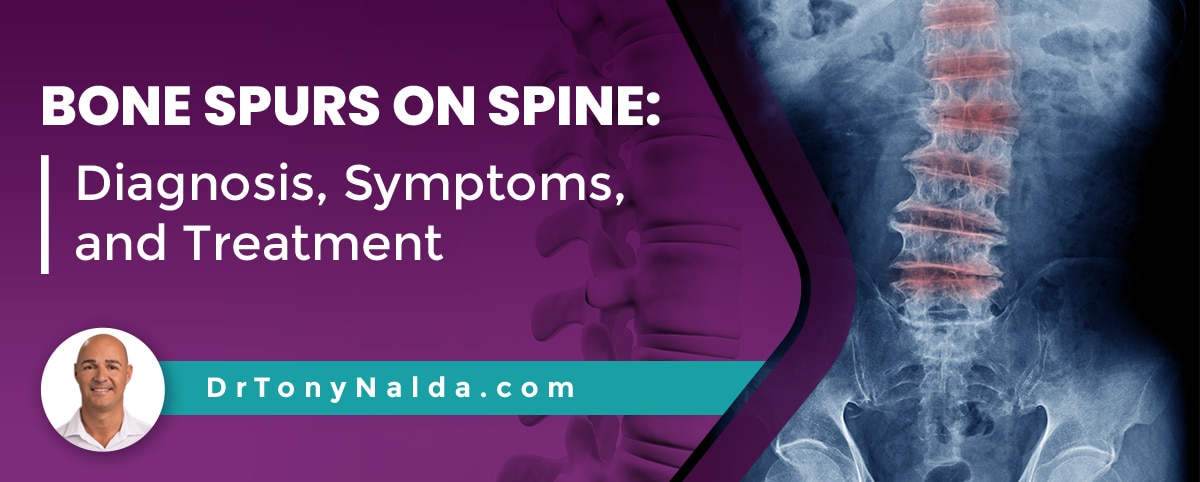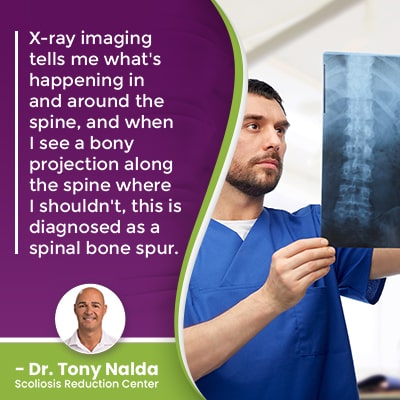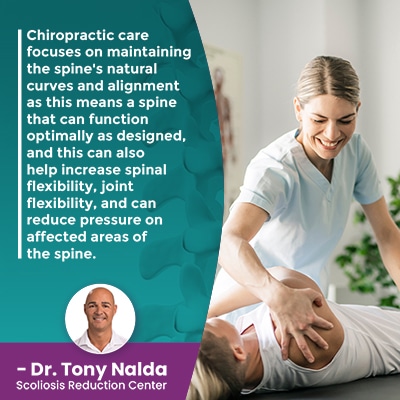Bone Spurs On Spine: Diagnosis, Symptoms, and Treatment

The spine allows us to stand upright, practice good posture, move flexibly, and the spinal cord within works in tandem with the brain to form the central nervous system (CNS). When there is excessive bone growth on the edge of a bone, its surroundings can become compressed by the new bone, and this can cause a number of issues felt throughout the body.
Bones are made of living tissue that is constantly renewing itself, but what happens if bone grows where it shouldn't? Bone spurs on the spine are diagnosed when bony projections have formed on the edges of vertebrae, or in the joints where they meet. Bone spurs can cause a loss of space within, and around, the spine.
Before getting to the specifics of how bone spurs on spine is diagnosed, let's start with some basic spinal anatomy.
Table of Contents
Anatomy of a Healthy Spine
A healthy spine has its natural and healthy curves in place, which is what makes it appear straight when viewed from the front and/or back, and gives it a soft 'S' shape when viewed from the sides.
When the spine's natural curves are in place, its vertebrae (bones of the spine) are stacked on top of one another as they should be, and this facilitates the spine's optimal health and function.
Between adjacent vertebrae sits an intervertebral disc, and those discs are also key to preserving spinal health and function.
The intervertebral discs give the spine structure as adjacent vertebrae attach to the disc in between; they also combine forces to facilitate flexible movement, provide cushioning between vertebrae, and act as the spine's shock absorbers.
Now, in a healthy spine, its individual structures have the space they need to function optimally within, and this also includes the spinal nerves, of which there are 31 pairs that make up the spinal cord; the nerve roots exit the spine at various locations and have pathways that extend throughout the body.
For example, the sciatic nerve starts in the lumbar spine (lower back) and extends down the back of the buttock, hip, leg, and into the foot.
Nerves also need a lot of space to function within, and if for some reason, a nerve experiences a loss of space and becomes compressed (exposed to uneven pressure), the nerve can become irritated, inflamed, and/or impinged.
Now that we have a basic understanding of spinal anatomy, let's move on to the specifics of bone spurs and how they are diagnosed on the spine.
Diagnosing Spinal Bone Spurs
In most cases, bone spurs are diagnosed via a physical examination and X-ray imaging tests performed on affected bones and joints.
 X-ray imaging tells me what's happening in and around the spine, and when I see a bony projection along the spine where I shouldn't, this is diagnosed as a spinal bone spur.
X-ray imaging tells me what's happening in and around the spine, and when I see a bony projection along the spine where I shouldn't, this is diagnosed as a spinal bone spur.
Bone spurs are also known as osteophytes. If a diagnosis of spinal osteophytes is reached, their location within the spine, severity, and cause will shape the type of symptoms a patient is likely to experience, and these factors will also inform the design of customized treatment plans.
Symptoms of Bone Spurs
It's a fairly common scenario that patients found out about their bone spurs by accident; oftentimes, this is during a routine X-ray for another reason, and in these types of cases, noticeable symptoms aren't present.
In other cases, however, bone spurs can cause pain and/or a decreased range of motion in the affected joints of the spine.
Symptoms will depend on key condition/patient variables such as cause, patient age, severity, and location within the spine; in most spinal conditions/issues, the area of the body located closest to the affected spinal section is the most likely to feel the condition's direct effects.
For example, bone spurs that develop in the lumbar spine are likely to cause symptoms experienced by the lower body, while bone spurs that develop on a knee can make it difficult to fully extend and bend the leg.
Bone spurs that develop in the upper spine are most likely to affect the upper extremities by how they affect nearby nerves.
Bone spurs in the hip can make movement painful, causing a reduced range of motion, and can also affect the knee and the lower body in general.
When bone spurs develop on the spine, they can cause a loss of space for the spinal cord, and the nerves within, to function within.
If a bone spur is projecting into the space within the spinal cord, it can compress/impinge a corresponding nerve root, causing pain that radiates and is felt anywhere along the affected nerve's pathway, and this can also include sensations of numbness, tingling, or weakness in the body's extremities.
Treatment Options for Spinal Bone Spurs
In order to treat bone spurs effectively, their underlying cause has to first be determined and addressed in treatment.
The most common cause of bone spurs on the spine is osteoarthritis that causes joint damage due to arthritic changes.
Also referred to as degenerative joint disease and/or wear-and-tear arthritis, osteoarthritis is the most common type of arthritis, particularly in adults over the age of 50.
While treatment options for bone spurs do include bone spur removal through bone spur surgery, like all surgical procedures, there are risks involved that need to be considered carefully.
There are also pain medications that can help reduce painful symptoms, but this is only addressing pain as a symptom, and not its underlying cause, so the effects of medication are only short term.
Steroid injections can also help reduce inflammation, and these injections can be guided by ultrasound for precision.
When it comes to a reduced range of motion, rest and activity modification can help, and physical therapy can help address poor posture, work towards strengthening weak joints, and a number of therapies such as low-level laser therapy can also help with pain, inflammation, and soft-tissue mobilization.
When physical therapy helps increase core strength and improve a reduced range of motion, it's also improving the spine's overall strength by taking pressure off of it and its individual structures; the spine's surrounding muscles can become strong enough to support it optimally, and this takes pressure of the affected spinal segment and its nearby nerves.
Developing spinal bone spurs can also be related to certain lifestyle factors that have a cumulative effect on spinal health and function over time.
Maintaining healthy weight is important because carrying excess weight means the spine has more to support, has more pressure on its individual parts, and can cause friction between vertebral bodies, causing the joints to wear faster and unevenly.
While condition-specific chiropractic care can't remove extra bone, it can help reduce pain and relieve pressure by adjusting the position of affected vertebrae and improving the health of a bone spur's surroundings: increasing circulation, for example.
 Chiropractic care focuses on maintaining the spine's natural curves and alignment as this means a spine that can function optimally as designed, and this can also help increase spinal flexibility, joint flexibility, and can reduce pressure on affected areas of the spine.
Chiropractic care focuses on maintaining the spine's natural curves and alignment as this means a spine that can function optimally as designed, and this can also help increase spinal flexibility, joint flexibility, and can reduce pressure on affected areas of the spine.
In some cases, making improvements to spinal stability and mobility by restoring its healthy curves and alignment through chiropractic adjustments is addressing the issue behind the development of the bony growths and can result in the body absorbing the bone spur.
Issues of nerve compression/impingement can also be eased by chiropractic care that reduces pressure on the spinal nerves, and this can result in long-term sustainable pain relief.
Conclusion
Bone spurs grow where they shouldn't, taking space from a bone/joint's surroundings, and this can either go unnoticed, or involve symptoms that range from dull pain, radiating pain, muscle weakness, and a reduced range of motion in the area of the body located closest to the affected bone/joint.
When bone spurs form on the spine, they grow on the edges of the spine's bones (vertebrae), or where they meet, in the joints.
Osteoarthritis is the most common cause of spinal bone spurs; the condition affects joint cartilage that facilitates the smooth gliding motion of vertebral bodies during movement.
There are a number of reasons for the spine to experience degenerative changes, one of which is natural age-related spinal degeneration, and when the spine starts to deteriorate, its ability to maintain its natural curves and alignment can be affected.
Through chiropractic care that involves a series of manual adjustments and techniques, spinal alignment can be improved by working towards adjusting the position of affected vertebrae back into alignment with the rest of the spine, and in some cases of spinal bone spurs, the body attempts to absorb the new bone growth.
Here at the Scoliosis Reduction Center, I don't just rely on chiropractic care to address spinal bone spurs, but also physical therapy that can address postural issues, muscle weakness and/or imbalance, increase spinal strength, flexibility, and most importantly, can increase the strength of the spine's surrounding muscles so the spine is optimally supported and there is less pressure on its individual structures and nerve roots.
Dr. Tony Nalda
DOCTOR OF CHIROPRACTIC
After receiving an undergraduate degree in psychology and his Doctorate of Chiropractic from Life University, Dr. Nalda settled in Celebration, Florida and proceeded to build one of Central Florida’s most successful chiropractic clinics.
His experience with patients suffering from scoliosis, and the confusion and frustration they faced, led him to seek a specialty in scoliosis care. In 2006 he completed his Intensive Care Certification from CLEAR Institute, a leading scoliosis educational and certification center.
About Dr. Tony Nalda
 Ready to explore scoliosis treatment? Contact Us Now
Ready to explore scoliosis treatment? Contact Us Now





